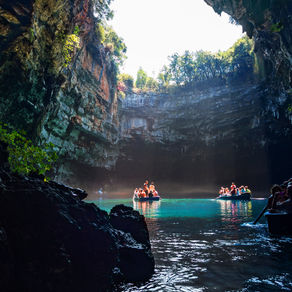Milos Mining History | Unveiling the Legacy from Ancient Obsidian to Modern Perlite
- Shiny Greece
- Dec 16, 2019
- 3 min read
Updated: Mar 25
Authors
George - The Shiny Greece Team (feat. ai)
Milos is an island famous for its mining history, which dates back thousands of years. The island has been a source of valuable minerals and rocks since ancient times, and its mining industry has played a significant role in shaping the island's economy, society, and culture. In this article, we explore the fascinating history of Milos mining, from its earliest beginnings to the present day. We examine the different types of minerals and rocks that have been extracted from the island, the techniques and tools used by miners throughout the centuries, and the impact of mining on Milos and its people. We also discuss the challenges and opportunities facing the island's mining industry in the 21st century.

Milos Mines | Photo by: iStock.com, tella_db
Beginnings of Milos Mining
Milos has been a source of minerals and rocks for thousands of years. Archaeological evidence suggests that the ancient inhabitants of Milos were already mining obsidian, a naturally occurring volcanic glass used for making tools and weapons, as early as the 8th millennium BCE (Neolithic Age). The island's strategic location in the Aegean Sea, as well as its abundance of natural resources, made it a highly desirable place for mining and trade. In 1800 BC (during the Bronze Age) Milos developed trade of obsidian and pottery, and the making of ceramics and medicine started from kaolin. These activities continued in the Geometric Age and the Archaic Period. During the Classical and Hellenistic periods, Milos became a major center of mining and metallurgy. The island's deposits of lead, silver, and copper were highly prized by the Greeks, who used them to produce coins, weapons, and other metal objects. Milos also produced a variety of industrial minerals, such as sulfur, alum, bentonite, trachite, alunite, and gypsum, which were used for construction, medicine, soap, and other purposes. The Roman period saw a continuation of the mining activities on Milos, as the island's resources were still in high demand. Milos was also famous for its quarries, which produced a type of white marble known as "Milosian" or "Aphrodite's marble". This high-quality marble was used for sculpting and architecture and was exported to other parts of the Mediterranean.

Mining Carriage of the 1st Half of the 20th Century in the Milos Mining Museum | Photo by: Zde, Mining carriage, 20th c, Milos Mining Museum, 153019, modified by Shiny Greece, CC BY-SA 4.0
Medieval and Modern Mining
The Byzantine period saw a decline in the mining activities on Milos, as the island was subjected to frequent pirate raids and invasions. However, the island's mines and quarries were still in operation, and the Venetians, who controlled Milos from the 13th to the 16th century, continued to exploit its mineral resources. During the Ottoman period, Milos experienced a resurgence of mining activity, as the Turks recognized the island's strategic importance and its potential for economic development. The Ottomans encouraged the mining of sulfur, which was used for gunpowder, as well as the extraction of other minerals and rocks. The mining industry on Milos continued to flourish under the Greek state, which gained independence from the Ottoman Empire in 1830. The 20th century saw significant changes in Milos mining, as new technologies and techniques were introduced. There came the wide exploitation of sulfur, silver, manganese, kaolin, bentonite, perlite, baryte, pozzolan in several locations of the island. The island's mines were modernized, and new minerals were discovered, such as perlite, bentonite, and kaolin. These industrial minerals were used in a variety of applications, including construction, insulation, and ceramics. Milos also became a center of pumice mining, as the island's volcanic rocks were in high demand for abrasives, filters, and other industrial products.

Rocks from the Manganese Mines in Vani | Photo by: Kkanak, Vrahia apo ta Metalleia Magganiou sto Vani, CC BY-SA 4.0
Challenges and Opportunities
Today, Milos is a center of perlite and pumice mining. Its mining industry has played a significant role in shaping the island's economy, society, and culture. Milos mining history is a testament to the ingenuity and resourcefulness of human beings, as well as the importance of natural resources in human civilization.
































































A great story of earth!
You have to go to Milos Mining Museum https://www.milosminingmuseum.com/en/ 😍